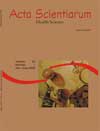<b>The focus group technique as a method of evaluating teenager knowledge of oral health</b>- DOI: 10.4025/actascihealthsci.v31i2.5830
Keywords:
focus groups, adolescence, oral health
Abstract
This study aims to the understanding of adolescents regarding oral health, using the Focus Group technique. The study was conducted at three public schools in the city of Araçatuba, São Paulo State, Brazil, with ten students in each. In order to conduct the focus groups, the following words, which featured high error levels, were addressed in survey questions on oral health: oral health; plaque, permanent teeth; fluoride; gum bleeds?; dental floss; transmission of cavities. During the discussions in the focus groups, it was observed that many teenagers were surprised at the situation to which they were submitted and at the topic they were discussing. The word ‘oral health’ was associated with the condition of cleanliness of the oral cavity, not identifying oral health as part of general health. The term ‘transmission of cavities’ did not have a sufficient understanding. The term ‘permanent tooth’ was well understood and was associated with a type of tooth that would not be replaced. The word ‘fluoride’ had more association with the task of cleaning than protection of the teeth. It is concluded that the use of the focus group technique is of great importance in the interpretation of the knowledge of adolescents on oral health and the appropriateness of the terminology of questionnaires on the same subject.Downloads
Download data is not yet available.
Published
2009-09-17
How to Cite
Francisco, K. M. S., Sundefeld, M. L. M. M., Garbin, A. J. Ísper, & Garbin, C. A. S. (2009). <b>The focus group technique as a method of evaluating teenager knowledge of oral health</b>- DOI: 10.4025/actascihealthsci.v31i2.5830. Acta Scientiarum. Health Sciences, 31(2), 165-170. https://doi.org/10.4025/actascihealthsci.v31i2.5830
Issue
Section
Dentistry Articles
DECLARATION OF ORIGINALITY AND COPYRIGHTS
I Declare that current article is original and has not been submitted for publication, in part or in whole, to any other national or international journal.
The copyrights belong exclusively to the authors. Published content is licensed under Creative Commons Attribution 4.0 (CC BY 4.0) guidelines, which allows sharing (copy and distribution of the material in any medium or format) and adaptation (remix, transform, and build upon the material) for any purpose, even commercially, under the terms of attribution.
Read this link for further information on how to use CC BY 4.0 properly.























5.png)







